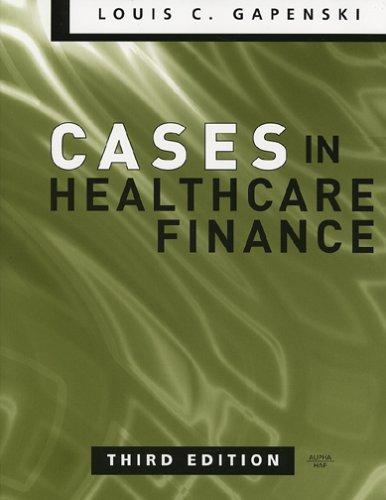Question
Problem 13-16 Simulation Singleton Supplies Corporation (SSC) manufactures medical products for hospitals, clinics, and nursing homes. SSC may introduce a new type of X-ray scanner
Problem 13-16 Simulation
Singleton Supplies Corporation (SSC) manufactures medical products for hospitals, clinics, and nursing homes. SSC may introduce a new type of X-ray scanner designed to identify certain types of cancers in their early stages. There are a number of uncertainties about the proposed project, but the following data are believed to be reasonably accurate.
| Probability | Developmental costs | Random Numbers |
| 0.3 | $1,600,000 | 00-29 |
| 0.4 | 3,807,500 | 30-69 |
| 0.3 | 6,000,000 | 70-99 |
| Probability | Project Life | Random Numbers |
| 0.2 | 2 years | 00-19 |
| 0.6 | 7 years | 20-79 |
| 0.2 | 15 years | 80-99 |
| Probability | Sales in Units | Random Numbers |
| 0.2 | 100 | 00-19 |
| 0.6 | 240 | 20-79 |
| 0.2 | 300 | 80-99 |
| Probability | Sales Price | Random Numbers |
| 0.1 | $11,300 | 00-09 |
| 0.8 | 12,200 | 10-89 |
| 0.1 | 13,100 | 90-99 |
| Probability | Cost per Unit (Excluding Developmental Costs) | Random Numbers |
| 0.3 | $5,000 | 00-29 |
| 0.4 | 6,000 | 30-69 |
| 0.3 | 7,200 | 70-99 |
SSC uses a cost of capital of 14% to analyze average-risk projects, 12% for low-risk projects, and 20% for high-risk projects. These risk adjustments primarily reflect the uncertainty about each project's NPV and IRR as measured by the coefficients of variation. The firm is in the 40% federal-plus-state income tax bracket.
- What is the expected IRR for the X-ray scanner project? Base your answer on the expected values of the variables. Also, assume the after-tax "profits" figure that you develop is equal to annual cash flows. All facilities are leased, so depreciation may be disregarded. Round the answer to two decimal places. _____________%
- Assume that SSC uses a 14% cost of capital for this project. What is the project's NPV? Round your answer to the nearest cent. $__________________
- Show the process by which a computer would perform a simulation analysis for this project. Use the random numbers 44, 17, 16, 58, 1; 79, 83, 86; and 19, 62, 6 to illustrate the process with the first computer run. Assume the cash flows for each year are independent of cash flows for other years. Calculate the following values, assuming the computer operates as follows: (1) A developmental cost and a project life are estimated for the first run using the first two random numbers. Developmental costs: $ ___________ Project life: ___________ years (2) Next, sales volume, sales price, and cost per unit are estimated using the next three random numbers and used to derive a cash flow for the first year. Sales volume: __________ units Sales price: $ ____________ Cost per unit: $ ___________ After-tax cash flow for Year 1: $ ___________ (3) Then, the next three random numbers are used to estimate sales volume, sales price, and cost per unit for the second year, hence the cash flow for the second year. Sales volume: _________ units Sales price: $ _________ Cost per unit: $ ___________ After-tax cash flow for Year 2: $ ___________ (4) Cash flows for other years are developed similarly, on out to the first runs estimated life. Sales volume: _________ units Sales price: $ _________ Cost per unit: $ __________ After-tax cash flow for Year 3: $ ____________ (5) With the developmental cost and the cash flow stream established, NPV and IRR for the first run are derived and stored in the computer's memory. IRR: __________% NPV: $ ____________ (6) The process is repeated to generate perhaps 500 other NPVs and IRRs. (7) Frequency distributions for NPV and IRR are plotted by the computer, and the distributions' means and standard deviations are calculated. Make a decision about how symmetrical the data would be.
Step by Step Solution
There are 3 Steps involved in it
Step: 1

Get Instant Access to Expert-Tailored Solutions
See step-by-step solutions with expert insights and AI powered tools for academic success
Step: 2

Step: 3

Ace Your Homework with AI
Get the answers you need in no time with our AI-driven, step-by-step assistance
Get Started


